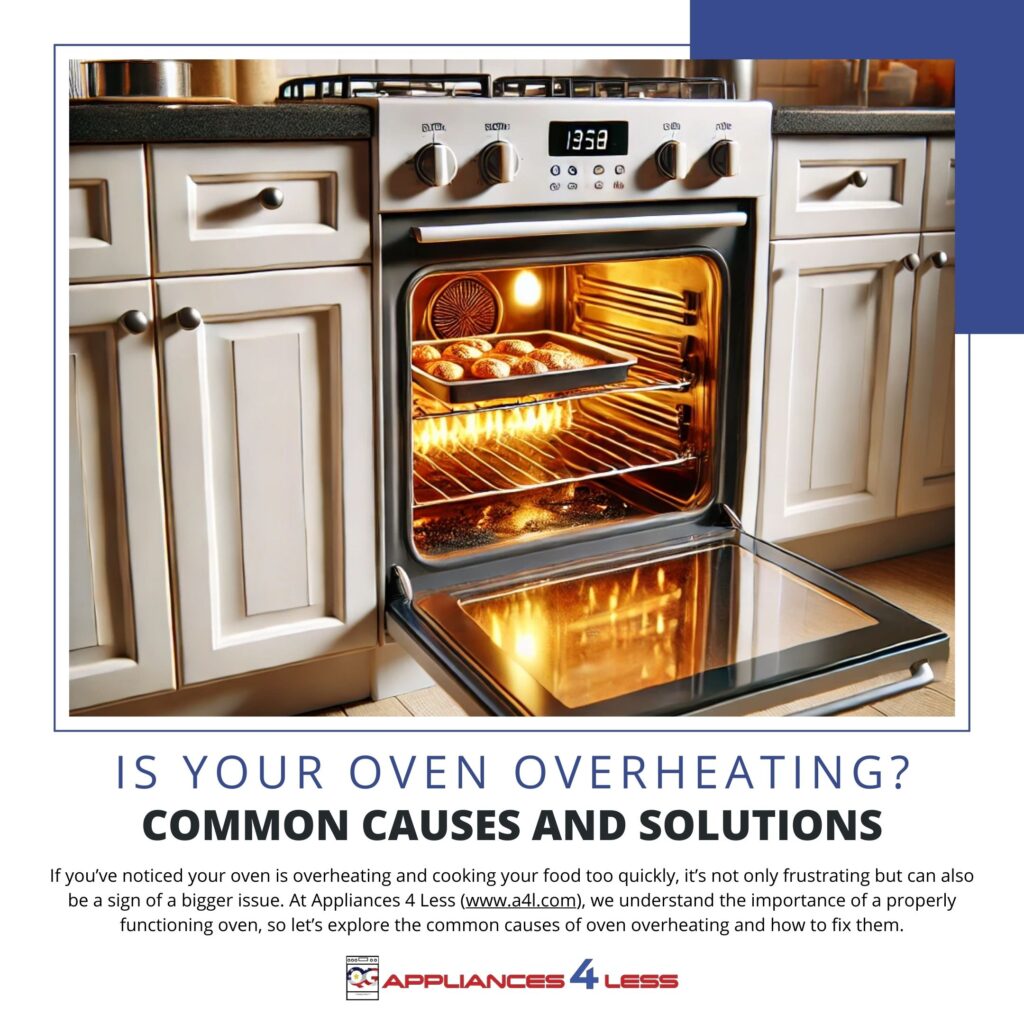Is Your Oven Overheating? Common Causes and Solutions
If you’ve noticed your oven is overheating and cooking your food too quickly, it’s not only frustrating but can also be a sign of a bigger issue. At Appliances 4 Less (www.a4l.com), we understand the importance of a properly functioning oven, so let’s explore the common causes of oven overheating and how to fix them.

What Causes an Oven to Overheat?
1. Faulty Thermostat- One of the most common reasons for an oven overheating is a malfunctioning thermostat. The thermostat controls the temperature inside the oven, so if it’s faulty, the oven may heat up beyond the set temperature, leading to overcooked or burnt food.
Solution- You can test your oven’s thermostat using an oven thermometer. If the temperature inside the oven doesn’t match the setting on the control panel, it’s likely time to replace the thermostat.
2. Broken Temperature Sensor- Modern ovens come equipped with a temperature sensor that works with the thermostat to regulate heat. If this sensor is broken or misaligned, it can cause the oven to overheat.
Solution: Check the position of the temperature sensor. If it’s touching the oven wall, it might be giving false readings. If adjusting its position doesn’t work, you may need to replace the sensor.
3. Malfunctioning Heating Elements- An oven has heating elements located at the top and bottom. If either of these elements becomes damaged or starts to malfunction, they can cause uneven heating or overheating.
Solution: Visually inspect the heating elements for any visible signs of damage, such as burns, cracks, or breaks. If you notice any damage, replacing the faulty heating element can solve the problem.
How to Troubleshoot an Overheating Oven
1. Use an Oven Thermometer- One of the easiest ways to check if your oven is overheating is by placing an oven thermometer inside. Set your oven to a specific temperature and compare the internal reading to the thermometer. If the oven temperature is significantly higher, you have an overheating issue.
2. Inspect the Door Seal- A worn or damaged oven door seal can cause heat to escape, making the oven work harder to maintain the correct temperature. This can lead to overheating in certain areas.
Solution: Inspect the seal around your oven door. If it’s cracked or worn, replace it to prevent heat from escaping and ensure consistent cooking temperatures.
3. Check the Control Board- If your oven uses a control board to regulate temperature, a malfunction in the board can cause incorrect temperature readings, leading to overheating.
Solution: If all other components seem to be functioning correctly, the control board might be the problem. In this case, you may need to call a professional technician to repair or replace the board.
Preventing Future Overheating Issues
1. Regular Maintenance- Perform regular maintenance on your oven to keep it functioning properly. Clean the oven interior, inspect the heating elements, and check the door seals to prevent issues before they escalate.
2. Avoid Overloading the Oven- Overloading your oven with too many dishes at once can cause uneven heating and may lead to overheating. To avoid this, leave enough space between dishes to allow air to circulate properly.
3. Use Correct Oven Settings- Make sure you’re using the correct temperature settings for your recipes. Cooking at too high a temperature can overwork the oven and cause overheating over time.
When to Call a Professional
While many oven overheating issues can be resolved with basic troubleshooting, some problems may require professional repair. If you’ve tried the above solutions and your oven is still overheating, it’s best to contact a technician to diagnose and fix the issue.
If your oven is overheating, it’s important to address the issue promptly to avoid overcooked meals and potential damage to the appliance. By checking common causes such as a faulty thermostat, broken temperature sensor, or malfunctioning heating elements, you can often resolve the issue on your own. For more tips and quality appliances, visit Appliances 4 Less (www.a4l.com).
Oven Overheating, Fix Overheating Oven, Oven Temperature Issues, Troubleshoot Oven Problems, Oven Repair Tips